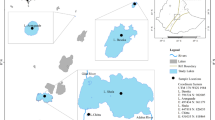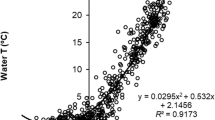Abstract
Nutrient, phytoplankton and zooplankton dynamics have been monitored intensively at Loch Leven for 34 years. The data collected reveal a decline in phosphorus concentrations, following major reductions in external nutrient loading, and large changes in its seasonal availability, particularly in recent years. More striking has been an increasing trend in water temperatures, annual means increasing by about 1 °C over the 34 years, with even greater increases observed for winter and spring periods. In response to these changes, there has been a general pattern of decline in measures of phytoplankton biomass (chlorophylla concentrations). Closer inspection reveals that the detailed response is, however, not so consistent with the environmental trends. A significant decline in chlorophylla concentrations occurred early on in the time series, before major reductions in nutrient availability. Correlation analysis revealed that this decline was associated with the re-appearance of Daphnia grazers. Further declines are only apparent in very recent years; correlation analysis and comparison of trends suggest that these were associated with the observed decline in nutrient concentrations. There was little correlation and no consistent relationship between annual measures of chlorophylla and water temperature, but winter mean values did show a consistent positive relationship. Spring Daphnia densities showed an even stronger, and significant, positive relationship with spring water temperatures. It is clear from this that the scale of climate change predicted in the future will significantly alter the functioning of shallow lakes and seasonal patterns in water quality. This is a particular concern in Europe with the implementation of the EC Water Framework Directive, as if the net effect of global warming on annual measures of water quality is negative, the principle aim of `good status' in all surface waters by 2016 will become even more difficult to achieve.
Similar content being viewed by others
References
Bailey-Watts, A. E. & A. Kirika, 1987. A re-assessment of the phosphorus inputs to Loch Leven (Kinross, Scotland): rationale and an overview of results on instantaneous loadings with special reference to runoff. Trans. Royal Soc. Edinburgh – Earth Sci. 78: 351–367.
Bailey-Watts, A. E. & A. Kirika, 1999. Poor water quality in Loch Leven (Scotland) in 1995, in spite of reduced phosphorus loadings since 1985: the influences of catchment management and inter-annual weather variation. Hydrobiologia 403: 135–151.
Carvalho L. & B. Moss, 1999. Climate sensitivity of a lowland acid lake. Freshwat. Biol. 42: 585–591.
Foy, R. H. & C. E. Gibson, 1993. The influence of irradiance, photoperiod and temperature on the growth kinetics of three planktonic diatoms. Europ. J. Phycol. 28: 203–212.
George, D. G., D. P. Hewitt, J. W. G. Lund & W. J. P. Smyly, 1990. The relative effects of enrichment and climate change on the long-term dynamics of Daphnia in Esthwaite Water, Cumbria. Freshwat. Biol. 23: 55–70.
Lund, J. W. G., 1955. Further observations on the seasonal cycle of Melosira italica (Ehr.) Kütz. subsp. subarctica O. Müll. J. Ecol. 43: 90–102.
Nõges, P., T. Nõges, L. Tuvikere, H. Smal, S. Ligeza, R. Kornijów, W. P¸eczula, E. Bécares, F. Garcia-Criado, C. Alvarez-Casrera, C. Gernandez-Alaez, C. Ferriol, R. M. Micracle, E. Vicente, S. Romo, E. Van Donk, W. van de Bund, J. P. Jensen, E. M. Gross, L.-A. Hansson, M. Gyllström, M. Nykänen, E. de Eyto, K. Irvine, D. Stephen, S. Collings & B. Moss, 2003. Factors controlling hydrochemical and trophic state variables in 86 shallow lakes in Europe. Hydrobiologia 506–509: 51–58.
Pettersson, K., K. Grust, G. Weyhenmeyer & T. Blenckner, 2003. Seasonality of chlorophyll and nutrients in Lake Erken – effects of weather conditons. Hydrobiologia 506–509: 75–81.
Psenner, R. & R. Schmidt, 1992. Climate-driven pH control of remote alpine lakes and effects of acid deposition. Nature 356: 781–783.
Reynolds, C. S., 1984, The ecology of freshwater phytoplankton. University Press, Cambridge: 384 pp.
Sas, H., 1989, Lake Restoration by Reduction of Nutrient Loading. Academica Verlag Richarz.
Scheffer, M., D. Straile, E. H. van Nes & H. Hosper, 2001. Climatic warming causes regime shifts in lake food webs. Limnol. Oceanogr. 46, 1780–1783.
Søndergaard, M., J. D. Jensen & E. Jeppesen, 2003. Role of sediment and internal loading of phosphorus in shallow lakes. Hydrobiologia 506–509: 135–145.
Author information
Authors and Affiliations
Rights and permissions
About this article
Cite this article
Carvalho, L., Kirika, A. Changes in shallow lake functioning: response to climate change and nutrient reduction. Hydrobiologia 506, 789–796 (2003). https://doi.org/10.1023/B:HYDR.0000008600.84544.0a
Published:
Issue Date:
DOI: https://doi.org/10.1023/B:HYDR.0000008600.84544.0a




